The Pringle Family Goes to Oregon
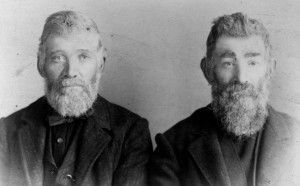
Clark S. Pringle and Octavius M. Pringle as older men. Octavius’s memoirs provide a startling account of his own trip over the Oregon Trail as a 14-year-old boy. Photo Source: Oregon State Library 2007.001.1060.
This article about the Pringle family’s journey on the Oregon Trail was originally published in the Statesman Journal on Sunday, September 4, 2016. It is reproduced here with citations and additional information for reference purposes.
The Oregon Trail has long been celebrated in romantic style, from Golden Pioneer statues atop our capitol building to costumed pageants, speeches and pioneer associations. Amid this glitter and sentiment, there remains grueling and sometimes graphic eyewitness accounts. Octavius Pringle’s story is one such tale. While most 14 year old boys today would be thinking about school or sports or other activities, Octavius’s adventures stand in stark contrast.
If the name Pringle sounds familiar to you, it may be due to the large number of features in Salem that still bear the name. Pringle Creek, Pringle School, and Pringle Parkade all trace their roots back to a family that came to Oregon from Missouri in 1846. The group consisted of Virgil Kellogg Pringle, his wife Pherne Tabitha Brown Pringle, six children, a grandmother, nephew and uncle.
[1] The first part of the journey was wearisome, but relatively uneventful. It did not remain that way. Despite sage advice from a family member making their second Oregon Trail trip with them, the Pringle family decided to take the southern route to Oregon rather than heading for the Columbia River and hanging a left at Portland. This decision had disastrous results.
The hardships of the trail forced the Pringles to abandon their wagons in the South Umpqua Canyon.[2] By the time they made it to the Calapooia Mountains, southeast of present day Cottage Grove, they were out of food and several hundred miles from where they were headed – the old Methodist Mission site in what would become Salem.[3] The family decided to send their teenage son, Octavius, on their only surviving horse to go on ahead and bring back food and help. He left with a couple of other young men from the wagon train bound for a rumored cache of supplies near present day Eugene.[4] Here Octavius was left to find his way back to his family with a meager supply of dried peas and graham flour. After traveling through the “gloomy drizzle,” he had to make the decision to continue on through the night or to camp and continue in the morning.
He remembered the night as an older man: “As the darkness slowly crept over the valleys and mountains…amidst the almost constant clang and squawk of waterfowl upon their annual migrations south, and in the dark woods close by, the hoo-ou-hoo-hoo-ho-o-o-hoo-osh of the big owl chorused by the chilling and lonesome producing k-a-z-e-az-zz-z-ea-rr of the little screech owl, accompanied by the long drawn-out lament of the ever present coyote. This was the serenade that accompanied my preparations for supper, which consisted of a half pint of graham flour moistened in a tin cup. When this was eaten I then prepared my bed by spreading a quilt over some hazel rods already in position under the fir trees and then wrapped the blanket around me as best I could to go to the sleep of forgetfulness, if possible, but this was not possible.”[5]
After the harrowing solo journey, the 14 year old did make it back to his family and with a hunk of venison given to him by a group of Native Americans he ran into on the trail to supplement the provisions. Octavius and his family eventually were reunited with the uncle who had warned them against the southern route. He showed up to save the day bringing pack horses and provisions for the rest of their journey. They arrived in what is now known as Salem on Christmas Day 1846, as one chronicler styled it, “in drizzling rain and flurrying snow, illy clad and hungry.”
Despite the hardships, the family made a successful life for themselves in Salem. Their grandmother (Tabitha Moffat Brown), who gained the moniker “Mother of Oregon,” started a boarding school for trial orphans, which would form the basis of the founding of Pacific University in Forest Grove. Parents Virgil and Pherne lived to celebrate their 60th wedding anniversary and the young Octavius went on to write up his adventures on the Oregon Trail. It was published under the name: “Experience of an Immigrant Boy in 1846-7.” We haven’t found an original copy, but it is copied liberally in Sarah Hunt Steeve’s “Book of Remembrance of Marion County, Oregon Pioneers, 1840-1860” Portland, Berncliff Press, 1927 (WHC 2000.027.0004). You can read a copy of it here. The account made its way to press again, serialized in R. J. Hendrick’s “Bits for Breakfast” column in the Oregon Statesman in 1937 (WHC 0083.035.0003).
Pringle Family Connections
The Pringle Family is connected to several other famous families and places in the Salem area and with at least two buildings on site here at the Willamette Heritage Center. It was getting so confusing, I had to make a chart.
Another Trail Tragedy
Son Clark Spencer Pringle married Catherine Carney Sager on . Sager was one of the famous Sager Orphans who lost their parents on the overland journey and ended up at the Whitman Mission. Catherine’s written memoirs provide another great account of trail trials and tribulations. You can read about the family and an excerpt from Catherine’s account here.
Bush Family Connection
Virgil and Pherne’s granddaughter, Lulu Hughes, daughter of Emma Pringle Hughes, married Asahel Nesmith Bush, the son of the Bush House builder Asahel Bush and another trail diary writer Eugenia Zieber.
Smith-Ohmart House
Virgil and Pherne’s oldest daughter Virgilia married Fabritus Reynolds Smith. Their family homstead – the historic Smith-Ohmart House (built in 1870) still stands on Nob Hill in South Salem. Virgilia and Fabritus Smith’s grandchild, Roy Virgil Ohmart, worked at the Thomas Kay Woolen Mill for 21 years as cashier.
Crafts of the Lee House
Octavius Pringle’s first wife was Emmaline Craft, a daughter of Charles Craft and Rebecca Jordan Craft. The Craft family lived for a time in the Lee House, as Charles Craft took over operations of the old Mission Sawmill located close by. The Crafts, too, were Oregon Trail settlers that arrived in 1845.
Sources:
[1] Ella Pringle Young’s Account. Dated 11 – 20 -1937 Oregon Statesman, Bits for Breakfast column. WHC 0083.005.0003.020. Lists six children on the journey. That would make sense as she was the 7th child born in Oregon in 1851. Her brother Octavius’s account, however, published just a few weeks before states 7 children crossed the plains, although neglects to name Ella in the list of children that crossed the trail, including instead nephew Charles P. Fullerton. Perhaps he was considered an adopted child? (For Octavius’s Account see “Experiences of an Immigrant Boy” dated 11-16-1937 Oregon Statesman Bits for Breakfast Column. WHC 0083.035.0003.017.
[2] Bits for Breakfast 11-14-1937 quoting Sarah Hunt Steeves Book. WHC 0083.035.0003.016.
[3] Octavius Pringle Account as told in Bits for Breakfast 11-17-1937. 0083.035.0003.018
[4] Ibid.
[5] Ibid.



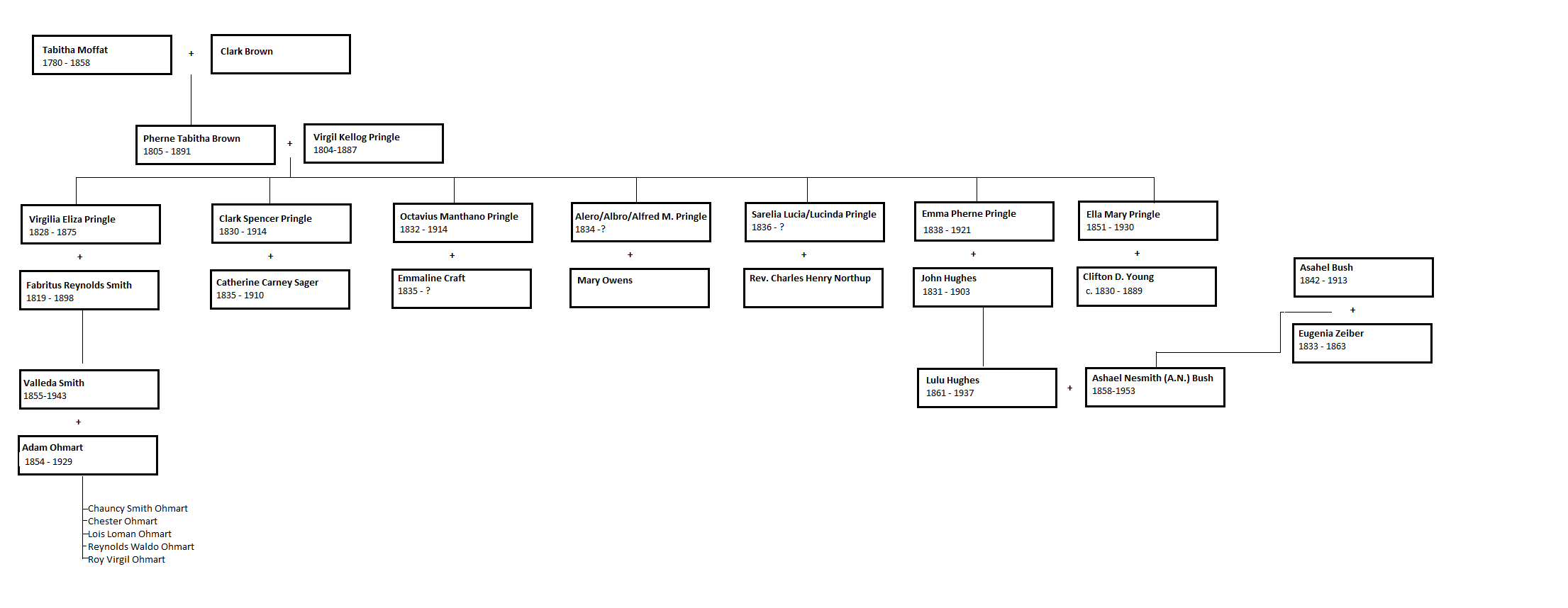
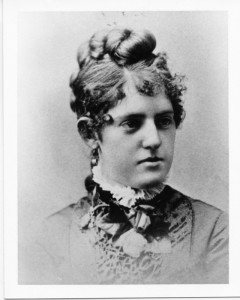
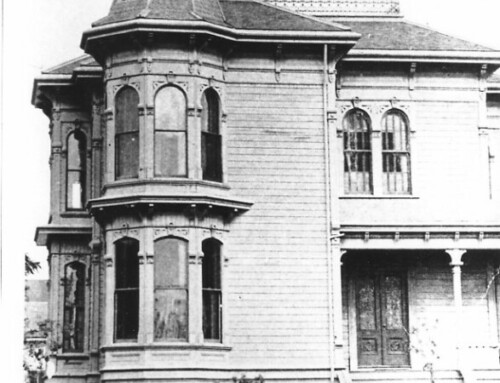
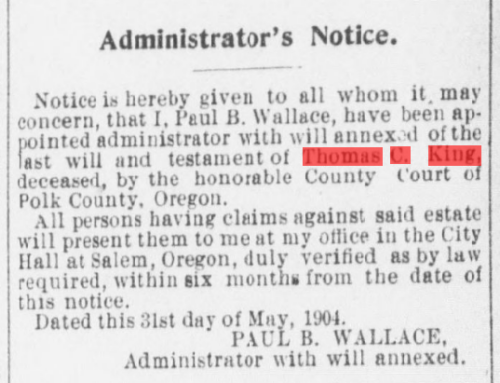


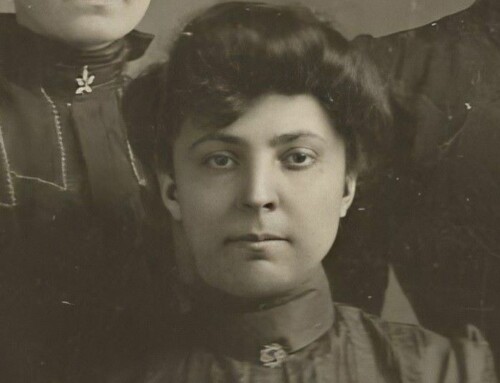
These people are my ancestors. Thankyou for your research and publication of fascinating Oregon history.